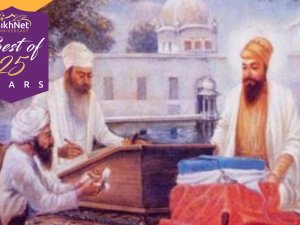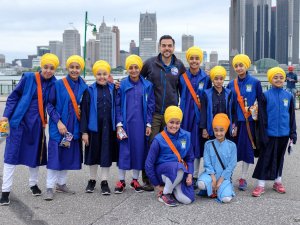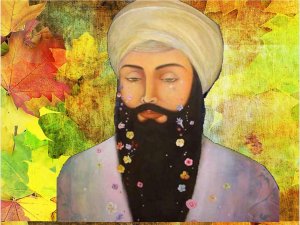It is widely accepted, as dictated by scholars and history books that six of the ten Sikh Guru's compositions have been included within Sri Guru Granth Sahib Ji (the first five Sikh Gurus, from Guru Nanak Dev Ji to Guru Arjan Dev Ji and the ninth Guru, Guru Tegh Bahadur Ji). However, after much deliberation and research into the original handwritten saroops of Sri Guru Granth Sahib Ji, under the guidance of Guru Gobind Singh Ji, it can be confirmed that the tenth Guru included his own composition within the Dohra found on Ang 1429. This dismisses the myth we have been led to believe that only six of the Sikh Guru's compositions were included within Sri Guru Granth Sahib, where in fact it was seven of the Gurus.
Here I will establish the pivotal event, which led to this Dohra to be written by the tenth Guru.
At the time when the ninth Guru, Guru Tegh Bahadur Ji was caged and imprisoned by Aurangzeb in 1675, he sent a letter to his son, Gobind Rai in Anandpur. Prior to Guru Tegh Bahadur Ji coming to Delhi, the Kashmiri Pandits begged the Guru to protect them from the oppressive regime of the Mughals, to which Gobind Rai supported and encouraged his father's decision to save them from persecution. The nine year old Gobind Rai said to his father, "O Father, who would be greater than you to defend the weak and helpless? Only you can save these people and their religion. My mother may become a widow from your great sacrifice, but you will save thousands of women from becoming widows; I may become fatherless from your great sacrifice, but you will save thousands of children from becoming orphans."
Guru Tegh Bahadur Ji was highly impressed by his son, who permitted him to sacrifice himself to uphold the justice of righteousness and the welfare of another nation.
The letter sent to Gobind Rai was a test from the Guru to see if his son, knowing that his father would soon be sacrificing himself, actually remained true to his declaration. This event has been further documented by Kavi Santokh Singh in the Gurpartap Suraj Parkash.
ਦੋਹਰਾ ॥
Dohraa:
ਬਲੁ ਛੁਟਕਿਓ ਬੰਧਨ ਪਰੇ ਕਛੂ ਨ ਹੋਤ ਉਪਾਇ ॥
My strength is exhausted, and I am in bondage; I cannot do anything at all.
Here Guru Tegh Bahadur Ji is informing his son that the time is drawing near. Everything is in the Lord's Will, he cannot do anything now to change it. The Guru's strength being exhausted and being in bondage is a suggestion to young Gobind Rai that he will now need to prepare to take the responsibility of leading the Sikh nation.
ਕਹੁ ਨਾਨਕ ਅਬ ਓਟ ਹਰਿ ਗਜ ਜਿਉ ਹੋਹੁ ਸਹਾਇ ॥੫੩॥
Says Nanak, now, the Lord is my Support; He will help me, as He did the elephant. ||53||
Guru Tegh Bahadur Ji accepts the Lord's Will and what will become of his fate. The Lord will support and assist the Guru in Delhi.
The letter reached Gobind Rai, who instantly understood the letter was a test from his father to see if he accepted the Lord's Will and if he was prepared to take on the role of a divine leader. In response to his father's letter, young Gobind Rai responded:
ਮਹਲਾ ੧੦:
Mahalla 10:
ਬਲੁ ਹੋਆ ਬੰਧਨ ਛੁਟੇ ਸਭੁ ਕਿਛੁ ਹੋਤ ਉਪਾਇ ॥
My strength has been restored, and my bonds have been broken; now, I can do everything.
Here Guru Gobind Singh Ji reassures his father that his strength has been restored through the willpower of his beloved father. With his father's strength and power, Gobind Rai can now lead the Sikh nation.
ਨਾਨਕ ਸਭੁ ਕਿਛੁ ਤੁਮਰੈ ਹਾਥ ਮੈ ਤੁਮ ਹੀ ਹੋਤ ਸਹਾਇ ॥੫੪॥
Nanak: everything is in Your hands, Lord; You are my Helper and Support. ||54||
Gobind Rai has accepted the Lord's Will through the blessings of Guru Nanak; the Lord and Guru Tegh Bahadur Ji are both the Helper and Support of Gobind Rai.
The testing of his son was a tradition which was prevalent amongst the previous Sikh Gurus, wherein the successor underwent various tests and challenges before becoming worthy of the Guruship. Guru Tegh Bahadur Ji realised that his son was ready to take the throne of the Guruship from the moment young Gobind Rai asked him to become the ultimate sacrifice at the altar of justice and righteousness.
The letter was placed in the Damdami Bir scribed by Bhai Mani Singh in 1704 under the guidance of Guru Gobind Singh Ji. Whether this manuscript contained Mahalla 10 is unknown, as the whereabouts or what really happened to this particular manuscript is uncertain; some believe it has gone missing from India (believed to be in Europe) or that it was severely damaged during the invasion by Abdali.
 Nevertheless, the handwritten manuscripts of Sri Guru Granth Sahib Ji by Baba Deep Singh were based on the original Damdami Bir written by Bhai Mani Singh, which contain Mahalla 10. One can only assume from this, that Mahalla 10 was present in the original manuscript.
Nevertheless, the handwritten manuscripts of Sri Guru Granth Sahib Ji by Baba Deep Singh were based on the original Damdami Bir written by Bhai Mani Singh, which contain Mahalla 10. One can only assume from this, that Mahalla 10 was present in the original manuscript.
It should also be noted that Guru Gobind Singh Ji is the only Sikh Guru who made use of the Dohra (rhyming couplet) in his compositions, which is evident within Sri Dasam Guru Granth and is a clear indicator that Guru Gobind Singh Ji added this particular Shabad. The use of Mahalla has come under some scrutiny as not being the written style of the tenth Guru, as the majority of Guru Gobind Singh Ji's compositions are assigned with Patshai 10. Nonetheless, we must understand that Guru Gobind Singh Ji has simply continued the style of the other Gurus throughout the Aad Granth by signposting the hymn/composition to the Guru at the beginning with a numeral figure (i.e. Mahalla 1, Mahalla 2, etc.). We must not limit the proficient and adept poetic skills of the tenth Guru, for Guru Gobind Singh Ji produced some of the finest compositions in various styles and forms.
It must equally be noted that not all the handwritten manuscripts of Guru Granth Sahib Ji contain Mahalla 10 but just the Dohra. Regardless, this Dohra should be equally respected as the composition of both the ninth and tenth Guru and is the written exchange between Guru Tegh Bahadur Ji and Guru Gobind Singh Ji. The Mahalla 10 highlights the poignant moment during this grand event and reminds us of the strength and courage of both father and son.
When one carefully examines the manuscripts with Mahalla 10 in them, they will find that the Dohra begins with the first couplet of the ninth Guru, followed by the tenth Guru's couplets signed under Mahalla 10. Unfortunately, the printed copies of Sri Guru Granth Sahib Ji today do not contain Mahalla 10 in them, which sadly reflect the tampered history and forcefully accepted belief that only six of the Gurus compositions are present within Sri Guru Granth Sahib Ji rather than seven. It is our moral duty to revive and expose this amazing piece of history, rather than casting a shadow over the truth.
"The Granth Sahib contains the compositions of Guru Nanak, Guru Angad, Guru Amar Das, Guru Ram Das Guru Arjan, Guru Teg Bahadur (the ninth Guru), a couplet of Guru Gobind Singh (the tenth Guru), panegyrics of bards who attended on the Gurus or admired their characters, and hymns of mediaeval Indian saints, a list of whom will subsequently be given."1
Below are some of the many handwritten Guru Granth Sahib Ji Saroops, where Mahlla 10/Daswan is included.
---------------------------------
1"The Sikh Religion Its Gurus, Sacred Writings and Authors" by Max Arthur Macauliffe VOL I Oxford University Press 1909





